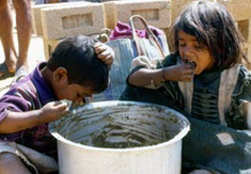Pneumonia major killer of children in Bangladesh
Pneumonia has been claiming the highest number of child lives in the country, despite a remarkable progress in under-five child survival for immunization and oral saline over the last three decades, pediatricians and health scientists said here yesterday. "Pneumonia is still the leading cause of childhood deaths in Bangladesh,' Steve Luby, agency head of Center for Disease Control and Prevention (CDC), US Embassy in Dhaka, told a symposium. Bangladesh Society for Paediatric Infectious Diseases (BSPID), a newly formed body of Paediatricians and health scientists, organised the two-day function at Bangladesh-China Friendship Conference Centre, where experts from home and abroad are participating. BSPID President and former director of Dhaka Shishu Hospital Prof Manzoor Hussain chaired the inaugural function, addressed by National Prof M R Khan, noted paediatrician Prof MQK Talukder, Prof Dr Satish Deopoojari of India, BSPID Secretary General Dr Samir K Saha, and BSPID Executives Dr Reaz Mobarak and Dr Mizanur Rahman. Steve Luby, also head of the programme on infectious disease of International Centre for Diarrhoeal Diseases Research, Bangladesh (ICDDR,B), said one in five children per 1,000 died within five years of their age during 1975, but this number has come down by 75 percent over the last three decades. "There is a 90 percent reduction alone in diarrhoea-specific deaths over last 30 years,' he said referring to the statistics of the latest Bangladesh Demographic and Health Survey (BDHS). He said Bangladesh is one of the three to four developing countries heading successfully towards achieving millennium development goals (MDGs). Steve Luby referred to the findings of a three-year community and hospital-based surveillance in urban Dhaka ended in 2007 and said meningitis, pneumonia, severe pneumonia and very severe pneumonia were common causes of child illnesses. He also said streptococcus, and influenza are important paediatric pathogens in Bangladesh. Answering to a question he said the problem of pneumonia necessitates a combined effort from paediatricians, parents and policymakers for further reduction in under-five child mortality and morbidity in the country, where prevalence of pneumonia is around 40 percent among sick children. He also expressed hope that the World Health Organization (WHO) would soon recommend alternative antibiotics of ampicillin and penicillin for such treatments at a low cost. Prof Talukder underscored the need for popularising breastfeeding further among mothers from all walks of life. The children who are not breastfed are four times susceptible to infection than the breastfed children, he pointed out and added that breastfeeding could be one of the best means to prevent child mortality. Prof Manzoor Hussain said the BSPID has been formed to work as a catalyst to groom specialised paediatricians and train general practitioners across the country to treat emerging and reemerging infections among children. The incidence and prevalence of infectious diseases among children are very high, despite successful running of the extended programme for immunization (EPI). "The emerging infection diseases such as nipah virus and HIV/AIDS need specialised persons to deal with,' he said, adding that the DSPID would work as an umbrella organisation to help the doctors who want to develop their career as 'infectious disease paediatricians.' A total of 125 doctors have already joined in BSPID for the purpose, he added. According to Unicef statistics, under-five child mortality mostly results from neonatal mortality, which makes up 55 percent of such deaths in Bangladesh. More than 120,000 neonates die within four weeks of their birth every year and most of these deaths occur at homes, where 90 percent of deliveries take place without proper safety. Malnutrition and lack of health education are seen two other factors killing children.



